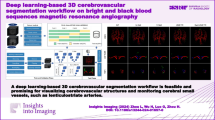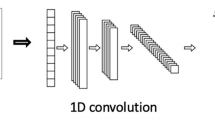Abstract
Knowledge of input blood to the brain, which is represented as total cerebral blood flow (tCBF), is important in evaluating brain health. Phase-contrast (PC) magnetic resonance imaging (MRI) enables blood velocity mapping, allowing for noninvasive measurements of tCBF. In the procedure, manual selection of brain-feeding arteries is an essential step, but is time-consuming and often subjective. Thus, the purpose of this work was to develop and validate a deep learning (DL)-based technique for automated tCBF quantifications. To enhance the DL segmentation performance on arterial blood vessels, in the preprocessing step magnitude and phase images of PC MRI were multiplied several times. Thereafter, a U-Net was trained on 218 images for three-class segmentation. Network performance was evaluated in terms of the Dice coefficient and the intersection-over-union (IoU) on 40 test images, and additionally, on externally acquired 20 datasets. Finally, tCBF was calculated from the DL-predicted vessel segmentation maps, and its accuracy was statistically assessed with the correlation of determination (R2), the intraclass correlation coefficient (ICC), paired t-tests, and Bland-Altman analysis, in comparison to manually derived values. Overall, the DL segmentation network provided accurate labeling of arterial blood vessels for both internal (Dice=0.92, IoU=0.86) and external (Dice=0.90, IoU=0.82) tests. Furthermore, statistical analyses for tCBF estimates revealed good agreement between automated versus manual quantifications in both internal (R2=0.85, ICC=0.91, p=0.52) and external (R2=0.88, ICC=0.93, p=0.88) test groups. The results suggest feasibility of a simple and automated protocol for quantifying tCBF from neck PC MRI and deep learning.








Similar content being viewed by others
Data Availability
Data will be made available on request to the corresponding author.
References
Vernooij MW et al (2008) Total cerebral blood flow and total brain perfusion in the general population: the Rotterdam Scan Study. J Cereb Blood Flow Metab 28(2):412–419
Nishimura T et al (2007) Decreased cerebral blood flow and prognosis of Alzheimer's disease: A multicenter HMPAO-SPECT study. Ann Nucl Med 21(1):15–23
Borghammer P et al (2008) Effect of memantine on CBF and CMRO<sub>2</sub>in patients with early Parkinson’s disease. Acta Neurologica Scandinavica 117(5):317–323
Pinkham A et al (2011) Resting quantitative cerebral blood flow in schizophrenia measured by pulsed arterial spin labeling perfusion MRI. Psychiatry Research: Neuroimaging 194(1):64–72
Ge Y et al (2012) Characterizing Brain Oxygen Metabolism in Patients with Multiple Sclerosis with T2-Relaxation-Under-Spin-Tagging MRI. J Cereb Blood Flow Metab 32(3):403–412
Siero JCW et al (2015) Neuronal activation induced BOLD and CBF responses upon acetazolamide administration in patients with steno-occlusive artery disease. Neuroimage 105:276–285
Piao R et al (2004) Cerebral hemodynamics and metabolism in adult moyamoya disease: Comparison of angiographic collateral circulation. Ann Nucl Med 18(2):115–121
Bandera E et al (2006) Cerebral Blood Flow Threshold of Ischemic Penumbra and Infarct Core in Acute Ischemic Stroke. Stroke 37(5):1334–1339
Ostergaard L et al (1998) Cerebral blood flow measurements by magnetic resonance imaging bolus tracking: comparison with [(15)O]H2O positron emission tomography in humans. J Cereb Blood Flow Metab 18(9):935–940
Frackowiak R, Lenzi G-L, Jones T, Heather JD (1980) Quantitative measurement of regional cerebral blood flow and oxygen metabolism in man using 15O and positron emission tomography: theory, procedure, and normal values. J Comput Assist Tomogr 4(6):727–736
Jahng G-H, Li K-L, Ostergaard L, Calamante F (2014) Perfusion magnetic resonance imaging: a comprehensive update on principles and techniques. Korean J Radiol 15(5):554–577
Alsop DC et al (2015) Recommended implementation of arterial spin-labeled perfusion MRI for clinical applications: a consensus of the ISMRM perfusion study group and the European consortium for ASL in dementia. Magn Reson Med 73(1):102–116
Choi KS (2022) Deep learning applications in perfusion MRI: recent advances and current challenges. Investig Magn Reson Imaging 26(4):246–255
Bernstein MA, King KF, Zhou XJ (2004) Phase Contrast. Handbook of MRI pulse sequences. Elsevier, pp 659–678
Wymer, D.T., K.P. Patel, W.F.B. III, and V.K. Bhatia, Phase-Contrast MRI: Physics, Techniques, and Clinical Applications. RadioGraphics, 2020. 40(1): p. 122-140.
Peng SL et al (2015) Optimization of phase-contrast MRI for the quantification of whole-brain cerebral blood flow. J Magn Reson Imaging 42(4):1126–1133
Khan MA et al (2017) Measurement of cerebral blood flow using phase contrast magnetic resonance imaging and duplex ultrasonography. J Cereb Blood Flow Metab 37(2):541–549
Lee H, Langham MC, Rodriguez-Soto AE, Wehrli FW (2017) Multiplexed MRI methods for rapid estimation of global cerebral metabolic rate of oxygen consumption. Neuroimage 149:393–403
Kaur P, Singh G, Kaur P (2018) A review of denoising medical images using machine learning approaches. Curr Med Imaging 14(5):675–685
Zhang W et al (2022) Motion Prediction of Beating Heart Using Spatio-Temporal LSTM. IEEE Signal Process Lett 29:787–791
Lee S, Jung S, Jung K-J, Kim D-H (2020) Deep Learning in MR Motion Correction: a Brief Review and a New Motion Simulation Tool (view2Dmotion). Investig Magn Reson Imaging 24(4):196–206
Wang G, Ye JC, Mueller K, Fessler JA (2018) Image Reconstruction is a New Frontier of Machine Learning. IEEE Trans Med Imaging 37(6):1289–1296
Zhu Y et al (2021) Deep learning-based predictive identification of neural stem cell differentiation. Nat Commun 12(1):2614
Rasheed J, Shubair RM (2022) Screening Lung Diseases Using Cascaded Feature Generation and Selection Strategies. Healthcare 10(7):1313
Cai L, Gao J, Zhao D (2020) A review of the application of deep learning in medical image classification and segmentation. Ann Transl Med 8(11):713
Rasheed, J. and S. Alsubai, A Hybrid Deep Fused Learning Approach to Segregate Infectious Diseases. Computers, Materials & Continua, 2023. 74(2): p. 4239--4259.
Shen D, Wu G, Suk HI (2017) Deep Learning in Medical Image Analysis. Annu Rev Biomed Eng 19:221–248
Sarvamangala DR, Kulkarni RV (2022) Convolutional neural networks in medical image understanding: a survey. Evol Intel 15(1):1–22
Dang, W., et al., A Feature Matching Method based on the Convolutional Neural Network. J Imaging Sci Technol 2023. 67(3).
Krizhevsky A, Sutskever I, Hinton GE (2017) ImageNet classification with deep convolutional neural networks. Commun. ACM 60(6):84–90
Lee D et al (2019) Deep learning in MR image processing. Investig Magn Reson Imaging 23(2):81–99
Malhotra, P., et al., Deep neural networks for medical image segmentation. Journal of Healthcare Engineering, 2022. 2022.
Mugler III, J.P. and J.R. Brookeman, Three‐dimensional magnetization‐prepared rapid gradient‐echo imaging (3D MP RAGE). Magn Reson Med, 1990. 15(1): p. 152-157.
Haacke EM, Xu Y, Cheng Y-CN, Reichenbach JR (2004) Susceptibility weighted imaging (SWI). Magn Reson Med 52(3):612–618
Haller S, Haacke EM, Thurnher MM, Barkhof F (2021) Susceptibility-weighted imaging: technical essentials and clinical neurologic applications. Radiology 299(1):3–26
Schneider CA, Rasband WS, Eliceiri KW (2012) NIH Image to ImageJ: 25 years of image analysis. Nat Methods 9(7):671–675
Ronneberger, O., P. Fischer, and T. Brox. U-net: Convolutional networks for biomedical image segmentation. in Medical Image Computing and Computer-Assisted Intervention–MICCAI 2015: 18th International Conference, Munich, Germany, October 5-9, 2015, Proceedings, Part III 18. 2015. Springer.
Penny, W.D., et al., Statistical parametric mapping: the analysis of functional brain images. 2011: Elsevier.
Kretschmann HJ, Kammradt G, Krauthausen I, Sauer B, Wingert F (1986) Brain growth in man. Bibl Anat 1986;(28):1-26.
Kety SS, Schmidt CF (1948) The Nitrous Oxide Method for the Quantitative Determination of Cerebral Blood Flow in Man: Theory, Procedure and Normal Values. J Clin Invest 27(4):476–83
Madsen PL, Holm S, Herning M, Lassen NA (1993) Average blood flow and oxygen uptake in the human brain during resting wakefulness: a critical appraisal of the Kety-Schmidt technique. J Cereb Blood Flow Metab 13(4):646–55
Zarrinkoob L et al (2015) Blood flow distribution in cerebral arteries. J Cereb Blood Flow Metab 35(4):648–54
Vestergaard MB et al (2017) Comparison of global cerebral blood flow measured by phase-contrast mapping MRI with (15) O-H(2) O positron emission tomography. J Magn Reson Imaging 45(3):692–699
Jang J et al (2013) Reflux venous flow in dural sinus and internal jugular vein on 3D time-of-flight MR angiography. Neuroradiology 55:1205–1211
Ruitenberg A et al (2005) Cerebral hypoperfusion and clinical onset of dementia: the Rotterdam Study. Ann Neurol 57(6):789–794
Sabayan B et al (2013) Total cerebral blood flow and mortality in old age: a 12-year follow-up study. Neurology 81(22):1922–1929
Wagenaar N et al (2019) Cerebral blood flow measured by phase-contrast magnetic resonance angiography in preterm and term neonates. Neonatology 115(3):226–233
Jiang D, Lu H (2022) Cerebral oxygen extraction fraction MRI: Techniques and applications. Magn Reson Med 88(2):575–600
Biondetti E, Cho J, Lee H (2023) Cerebral oxygen metabolism from MRI susceptibility. Neuroimage 276
Jain V, Langham MC, Wehrli FW (2010) MRI estimation of global brain oxygen consumption rate. J Cereb Blood Flow Metab 30(9):1598–1607
Lu H, Ge Y (2008) Quantitative evaluation of oxygenation in venous vessels using T2-relaxation-under-spin-tagging MRI. Magn Reson Med 60(2):357–363
Acknowledgements
The authors wish to thank Dr. Hyun-Soo Lee for her assistance with MRI protocol setting.
Funding
This research was supported by Dongil Culture and Scholarship Foundation, and by the MSIT (Ministry of Science and ICT), Korea, under the Innovative Human Resource Development for Local Intellectualization support program (IITP-2023-RS-2022-00156389).
Author information
Authors and Affiliations
Contributions
Jinwon Kim: Conceptualization, Methodology, Software, Data annotation, Investigation, Validation, Writing – original draft. Hyebin Lee: Investigation, Resources. Sung Suk Oh: Resources, Writing – review & editing. Jinhee Jang: Investigation, Validation, Resources, Writing – review & editing. Hyunyeol Lee: Conceptualization, Methodology, Data annotation, Investigation, Supervision, Writing – review & editing.
Corresponding author
Ethics declarations
Ethics Approval
The institutional review boards of Seoul St. Mary’s Hospital (Seoul, Korea) and Kyungpook National University (Daegu, Korea) approved this study.
Informed Consent
The requirement for Informed consent from the patients visiting Seoul St. Mary’s Hospital was waived due to retrospective nature of the study involving them. Informed written consent from the healthy subjects was obtained individually prior to the imaging experiments at Daegu-Gyeongbuk Medical Innovation Foundation (Daegu, Korea).
Competing Interests
The authors declare no conflict of interests to declare.
Additional information
Publisher's Note
Springer Nature remains neutral with regard to jurisdictional claims in published maps and institutional affiliations.
Rights and permissions
Springer Nature or its licensor (e.g. a society or other partner) holds exclusive rights to this article under a publishing agreement with the author(s) or other rightsholder(s); author self-archiving of the accepted manuscript version of this article is solely governed by the terms of such publishing agreement and applicable law.
About this article
Cite this article
Kim, J., Lee, H., Oh, S.S. et al. Automated Quantification of Total Cerebral Blood Flow from Phase-Contrast MRI and Deep Learning. J Digit Imaging. Inform. med. 37, 563–574 (2024). https://doi.org/10.1007/s10278-023-00948-0
Received:
Revised:
Accepted:
Published:
Issue Date:
DOI: https://doi.org/10.1007/s10278-023-00948-0




